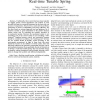562 search results - page 59 / 113 » Distinguishing between cause and effect |
BMCBI
2006
14 years 9 months ago
2006
Background: Multiple sequence alignment is the foundation of many important applications in bioinformatics that aim at detecting functionally important regions, predicting protein...
AIPS
2011
14 years 1 months ago
2011
The ignoring delete lists relaxation is of paramount importance for both satisficing and optimal planning. In earlier work (Hoffmann 2005), it was observed that the optimal relax...
FC
2010
Springer
15 years 1 months ago
2010
Springer
Abstract. Starting from algebraic properties that enable guessing lowentropy secrets, we formalize guessing rules for symbolic verification. The rules are suited for both off-line ...
3DPVT
2006
IEEE
15 years 3 months ago
2006
IEEE
Finding correspondences between two (widely) separated views is essential for several computer vision tasks, such as structure and motion estimation and object recognition. In the...
IROS
2006
IEEE
15 years 3 months ago
2006
IEEE
— Traditionally, robot control has been done typically by “highly precise control algorithms”: the position of each movable body part is accurately determined at any time wit...

